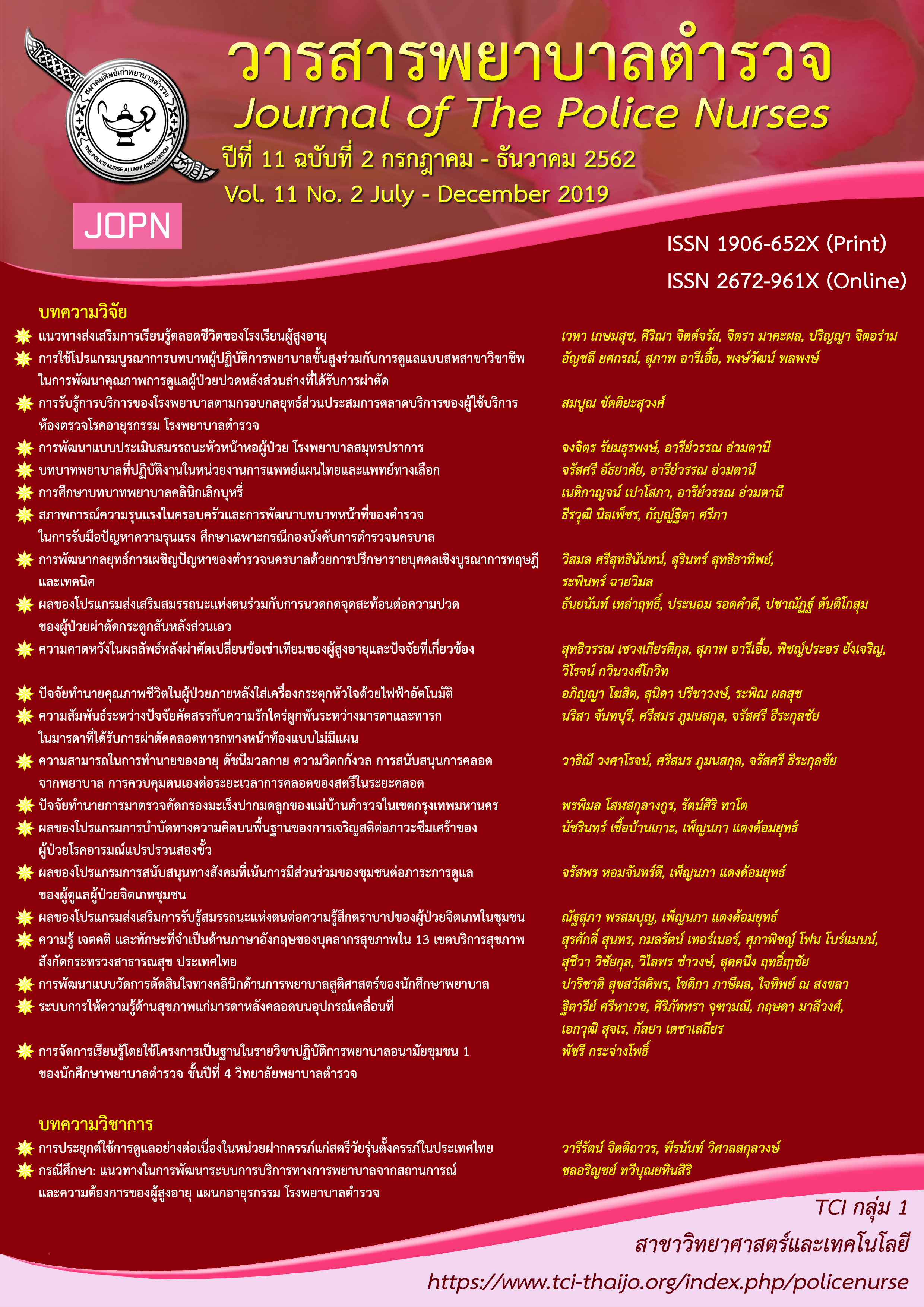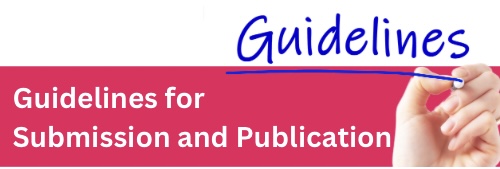THE PREDICTABILITY OF AGE, BODY MASS INDEX, ANXIETY, NURSE’S LABOUR SUPPORT, SELF CONTROL ON DURATION OF LABOUR OF WOMEN IN LABOUR
Keywords:
duration of labour, age, body mass index, anxiety, nurse’s labour support, self-controlAbstract
This predictive research aimed at exploring the predictability of age, body mass index, anxiety, nurse’s labour support and self-control on duration of labour of women in labour. The sample group was composed of laboring women who had normal labour and stayed at the postpartum ward and the private ward for OB-GYN patients at Ramathibodi Hospital, Bangkok metropolitan from September 2016 to December 2016. The sample group was selected by purposive selection which yielded a total of 100 subjects. Data were collected using questionnaires on personal information and birth, anxiety during labour, nurses’ labour support behaviors, and self-control during labour. Data were analyzed using descriptive statistics and stepwise multiple regression analysis.
According to the findings, only age was able to predict the duration of stage 1 of labour and accounted for 4 percent of variance explained (R2 = .04, F (1, 98) = 3.98, p = .04). The suggestion is that nurses should assess the age factor of women in labour to help plan proper care to reduce duration of labour. Studies of factors influencing duration of labour also yielded supporting and conflicting findings. Therefore, additional studies should be conducted to help women in labour have an appropriate duration of labour.
Downloads
References
Boonpongmanee, C., Chunuan, S., & Somsap, Y. (2005). Effects of empowerment and continuous support on psychological factors, pain coping behaviors, and birth outcomes. Songklanagarind Medical Journal, 23(1), 37-47. doi:10.1002/146 51858.CD003766.pub4
Cohen, J. (1988). Statistical power analysis for the behavior sciences (2nd ed.). Hillsdale, NJ: Lawrence Erlbaum.
Costa, D., Dritsa, M., Larouch, J., & Brender, W. (2000). Psychosocial predictors of labor delivery complications and infant birth weight: A prospective multivariate study. Journal of Psychosomatic Obstetrics & Gynaecology, 21(3), 137-148. doi:10.3109/01674820009075621
Cunningham, F. G., Leveno, K. J., Bloom, S. L., Spong, C. Y., Dashe, J. S., Hoffman, B. L., . . . Sheffield, J. S. (2014). Williams obstetrics (24th ed.). New York, NY: McGraw-Hill.
Gorrie, T. M., McKinney, E. S., & Murray, S. S. (1994). Foundations of maternal-newborn nursing. Philadelphia, PA: W. B. Saunders.
Hodnett, E. D., & Osborn, W. (1989). Effects of continuous intrapartum professional support on childbirth outcomes. Research in Nursing & Health, 12, 289-297. https://doi.org/10.1002/nur.4770120504
Hodnett, E. D., Gates, S., Hofmeyr, G. J., & Sakala, C. (2013). Continuous support for women during childbirth. Cochrane Database of Systematic Reviews, 7, 1-85. doi:10.1002/14651858.CD003766.pub5
Klaus, M., Kennell, J., Berkowitz, G., & Klaus, P. (1992). Maternal assistance and support in labor: Father, nurse, midwife, or doula. Clinical Consultations in Obstetrics and Gynecology, 4(4), 211-217.
Lederman, R. P. (1978). The relationship of maternal anxiety, plasma catecholamine and plasma cortisol to progress in labour. American Journal of Obstetrics & Gynecology, 25, 495 - 500. doi:10.1016/0002-9378(78)90742-1
London, N. K., Ladewig, P. W., Ball, J. W., & McGillis Bindler, R. C. (2003). Maternal newborn & child nursing family - centered care. Upper Saddle River, NJ: Prentice hall.
Lowdermilk, D. L., & Perry, S. H. (2004). Maternity and women’s health care (8th ed.). St. Louis, MO: Mosby.
Lowe, N. K. (2002). The nature of labour pain. American Journal of Obstetrics & Gynecology, 186, S16-S24. https://doi.org/10.1016/S0002-9378(02)701 79-8
Montgomery, K. S. (2003). Nursing care of pregnant adolescents. Journal of Obstetric Gynecologic & Neonatal Nursing, 32(2), 249-257. https://doi.org/ 10.1177/0884217503252191
Namey, E. E., & Lyerly, A. D. (2010). The meaning of “control” for childbearing women in the US. Social Science and Medicine, 71(4), 769-776. doi:10.1016/j.socscimed.2010.05.024
O’Hare, J., & Fallon, A. (2011). Women’s experience of control in labour and childbirth. British Journal of Midwifery, 19(3), 164-169. https://doi.org/10. 12968/bjom.2011.19.3.164
Phumonsakul, S., Suksanguan, P., & Khanobdee, C. (2016). Development of the labor support scale for intrapartum nurse. Ramathibodi Nursing Journal, 22(3), 247-262.
Promrak, P. (2004). The effect of integrated pain management program on labor pain, duration of first stage of labor, and childbirth experience in primiparous mother (Master of nursing science program, maternal and newborn nursing). Faculty of Medicine Ramathibodi Hospital, Mahidol University, Bangkok, Phayathai.
Sauls, D. J. (2002). Effect of labor support on mothers, babies, and birth outcomes. Journal of Obstetric, Gynecologic & Neonatal Nursing, 31(6), 733-741. doi:10.1177/0884217502239209
Spielberger, C. D., Lushene, R. E., & McAdoo, W. G. (1977). Theory and measurement of anxiety states. Handbook of modern personality theory, pp. 239-253.
Tuntanokij, J. (2005). The effects of childbirth training program for pregnant women and supporters on pain level, pain coping behaviors, laboring period and childbirth experience (Master of nursing science program, maternal and newborn nursing). Faculty of Medicine Ramathibodi Hospital, Mahidol University, Bangkok, Phayathai.
Wong, L. D., Perry, S. E., Hockenberry, M. J., Lowdermilk, D. D., & Wilson, D. (2002). Maternal child nursing care (3rd ed.). Philadelphia, PA: Mosby Elsevier.
World Health Organization. (2004). Appropriate body-mass index for Asian population and its implications for policy and intervention strategies. Lancet, 363(9403), 157-163. doi:10.1016/S0140-6736(03)15268-3
Downloads
Published
How to Cite
Issue
Section
License
ผลงานที่ได้ตีพิมพ์แล้วจะเป็นลิขสิทธิ์ของวารสารพยาบาลตำรวจ















